Intangible Cultural Heritage in the Yellow River Basin: Its Spatial–Temporal Distribution Characteristics and Differentiation Causes
Abstract
:1. Introduction
2. Research Methods and Data Processing
2.1. Research Methods
2.1.1. Standard Deviation Ellipse
2.1.2. The Nearest-Point Index
2.1.3. Nuclear Density Analysis
2.1.4. Spatial Autocorrelation
2.1.5. Geographical Detector
2.2. Data Source
3. Results and Analysis
3.1. Types of Intangible Cultural Heritage Structure in the Yellow River Basin
3.2. Distribution of Intangible Cultural Heritage Time Characteristics in the Yellow River Basin
3.3. Spatial Distribution of Intangible Cultural Heritage in the Yellow River Basin
3.3.1. Distribution Pattern of Intangible Cultural Heritage in the Yellow River Basin
3.3.2. Spatial Distribution Pattern of Intangible Cultural Heritage in the Yellow River Basin
3.3.3. Spatial Aggregation of Intangible Cultural Heritage in the Yellow River Basin
3.3.4. Spatial Correlation Analysis of Intangible Cultural Heritage in the Yellow River Basin
4. Influencing Factors
4.1. Selection of Influencing Factors
4.2. Single Factor Analysis
4.3. Interaction Analysis
5. Discussion
5.1. Discussion on the Temporal and Spatial Distribution of Intangible Cultural Heritage
5.2. Discussion on the Causes of Non-Inherited Differentiation
6. Discussion
- (1)
- According to what has been excavated, the intangible cultural heritage projects in the Yellow River Basin show a dense-east-sparse-west spatial distribution pattern. In the middle and lower reaches of the Yellow River Basin, a hot area centered on the central and southern Shanxi is formed. A cold point area centered on Alxa League is formed in the northern Yellow River Basin.
- (2)
- The intangible cultural heritage in the Yellow River Basin generally presents the “four peaks and three valleys” characteristics historically. The spatial distribution characteristics of various types are also different, and the oral tradition and manifestation of intangible cultural heritage are mainly composed of three high-density areas and four sub-high-density areas in the middle and lower reaches of the Yellow River. The intangible cultural heritage of performing arts in space is L shaped; the traditional handicrafts have a trunk–wings spatial distribution pattern; the spatial distribution pattern of knowledge and practice intangible cultural heritages related to nature and the universe consists of two high-density areas and four sub-high-density areas; social practice, rituals, and festivals are composed of two high-density areas and two sub-high-density areas. It can be seen from the NNI values of each batch that the state has been paying increasing attention to the development of intangible cultural heritage in economically backward areas and ethnic minority areas.
- (3)
- The spatial distribution pattern of intangible cultural heritage joint influence of policy orientation, economic development, topography, and other factors.
Author Contributions
Funding
Institutional Review Board Statement
Informed Consent Statement
Data Availability Statement
Acknowledgments
Conflicts of Interest
References
- Opinions on Further Strengthening the Protection of Intangible Cultural Heritage. Office of the State Council. 12 August 2021. Available online: http://www.gov.cn/gongbao/content/2021/content_5633447.htm (accessed on 17 February 2022).
- Bille, M. Assembling heritage: Investigating the Unesco proclamation of Bedouin intangible heritage in Jordan. Int. J. Herit. Stud. 2012, 18, 107–123. [Google Scholar] [CrossRef]
- Giudici, E.; Melis, C.; Dessì, S.; Ramos, B.F.P.G. Is intangible cultural heritage able to promote sustainability in tourism? Int. J. Qual. Serv. Sci. 2013, 5, 101–114. [Google Scholar]
- Cominelli, F.; Greffe, X. Intangible cultural heritage: Safeguarding for creativity. City Cult. Soc. 2012, 3, 245–250. [Google Scholar] [CrossRef]
- Wang, Y.; Bramlell, B. Heritage protection and tourism development priorities in Hangzhou, China: A political economy and governance perspective. Tour. Manag. 2012, 33, 988–998. [Google Scholar] [CrossRef]
- Xie, F. Review of foreign intangible cultural heritage related research. Guizhou Ethn. Stud. 2011, 3, 93–98. [Google Scholar]
- Cozzani, G.; Pozzi, F.; Dagnino, F.M.; Katos, A.V.; Katsouli, E.F. Innovative technologies for intangible cultural heritage education and preservation: The case of i-Treasures. Pers. Ubiquitous Comput. 2017, 2, 1–13. [Google Scholar]
- Arizpe, L. How to Reconceptualize Intangible Cultural Heritage; Springer International Publishing: Berlin Germany, 2015. [Google Scholar]
- Fromm, A.B. Ethnographic museums and intangible cultural heritage return to our roots. J. Mar. Isl. Cult. 2016, 5, 9–10. [Google Scholar] [CrossRef]
- Hiroyuki, H. Between Preservation and Tourism: Folk Performing Arts in Contemporary Japan. Asian Folk. Stud. 2003, 62, 225–236. [Google Scholar]
- Arizpe, L. Intangible cultural heritage, diversity and coherence. Mus. Int. 2004, 56, 130–136. [Google Scholar] [CrossRef]
- Robinson, R.N.S.; Clifford, C. Authenticity and festival food service experience. Ann. Tour. Res. 2012, 39, 571–600. [Google Scholar] [CrossRef]
- Xiang, Y. On the Concept and Category of “Oral and Intangible Heritage”. Folk. Cult. Forum 2004, 3, 69–73. [Google Scholar]
- Yang, Y. The origin, present situation and related problems of intangible cultural heritage concept. World Herit. 2003, 2, 27–31. [Google Scholar]
- Wu, X. A Preliminary Study on the Concept of Intangible Cultural Heritage. China Mus. 2004, 1, 66–70. [Google Scholar]
- Liu, K. Some theoretical reflections on the protection of intangible cultural heritage. Folk Cult. Forum 2004, 4, 51–54. [Google Scholar]
- Mu, Y.; Tan, H.; Liu, Z. An Introduction to Intangible Cultural Heritage; Beijing Normal University Press: Beijing, China, 2010. [Google Scholar]
- Tian, Q. On the generality and particularity of the protection of intangible cultural heritage in western China—Take the “Intangible Cultural Heritage Law” as the starting point. J. Minzu Univ. China 2012, 39, 95–101. [Google Scholar]
- Zhang, X.; Yu, H.; Chen, T.; Wang, X.; Wang, F. The Value Evaluation System and Application of Intangible Cultural Heritage Resource Tourism Development—Taking Suzhou City as an Example. Adv. Geogr. Sci. 2016, 35, 997–1007. [Google Scholar]
- Pu, L.; Xiao, L. Investigation and Research on the Status Quo of the Educational Inheritance of the Yi Nationality’s Long Narrative Poem “Ashima”. Ethn. Educ. Res. 2016, 27, 137–144. [Google Scholar]
- Hu, Z.; Liu, P.; Deng, Y.; Deng, Y.; Zheng, W.; Qiu, H. Recognition of Landscape Gene of Rucheng Intangible Cultural Heritage: Taking Incense Dragon as an Example. Human Geogr. 2015, 30, 64–69. [Google Scholar]
- Ding, Y. Study on the Policy Measures Related to the Systematic Protection of Intangible Cultural Heritage during the 14th Five-Year Plan Period. Manag. World 2020, 36, 22–35. [Google Scholar]
- Mang, Z.; Liu, Z. Several Key Issues on the Concept of Intangible Cultural Heritage Protection in China. Folk. Stud. 2019, 6, 39–46+157–158. [Google Scholar]
- Gao, B. The Future Folklore Outline of Daily Life. Folk. Stud. 2017, 1, 19–34+157. [Google Scholar]
- Dai, Q.; Liu, J.; Wu, Y.; Xu, W. Discussing the protection of Guangxi’s intangible cultural heritage from a regional perspective. Resour. Sci. 2013, 35, 1104–1112. [Google Scholar]
- Xu, B.; Pan, J. Spatial distribution characteristics and influencing factors of China’s national intangible cultural heritage. Econ. Geogr. 2018, 38, 188–196. [Google Scholar]
- Zhang, J.; Wen, J.; Liu, J.; Zhu, H. Spatial and temporal distribution characteristics and tourism response of intangible cultural heritage in Shanxi Province. Sci. Geogr. Sonics 2017, 37, 1104–1111. [Google Scholar]
- Jiang, J.; Yang, Q.; Zhang, Z.; Su, K. Spatial pattern and tourism development model of intangible cultural heritage in Chongqing. Econ. Geogr. 2019, 39, 205–213. [Google Scholar]
- Miao, H.; Zhang, M. Research on the Spatial Structure of “Intangible Cultural Heritage” Tourism Resources in Northwest Ethnic Areas Based on GIS Buffer Analysis. Resour. Environ. Arid. Areas 2014, 28, 179–186. [Google Scholar]
- Hao, J.; Lin, S.; Wang, G.; An, X.; Ren, Q. Distribution characteristics and utilization of the intangible cultural heritage tourism resources in Liaoning Province. World Reg. Stud. 2018, 27, 167–176. [Google Scholar]
- Wang, J.; Xu, C. Geodetector: Principle and prospective. Acta Geogr. Sin. 2017, 72, 116–134. [Google Scholar]
- Wang, J. Atlas of China; China Map Press: Beijing, China, 2004. [Google Scholar]
- Wang, H. Chinese Cultural Geography; Central China Normal University Press: Wuhan, China, 2010. [Google Scholar]
- Gong, S.; Li, Z.; Xie, H.; Wang, X.; Zhang, T.; Shi, G.; Chen, F. The temporal and spatial characteristics of epidemic in China in 3000 and its influencing factors. Acta Geogr. Sinica 2021, 76, 1976–1996. [Google Scholar]
- Chai, G.; Sun, W. Analysis on the spatial-temporal distribution and gravity center movement of intangible cultural heritage in Shanxi. Cult. Herit. Bimon. 2010, 2, 6–11. [Google Scholar]
- Han, S.; Xu, P.; Ma, P. Spatial and temporal distribution of intangible cultural heritage in Jiangsu and its influencing factors. Sci. Geogr. Sin. 2021, 41, 1598–1605. [Google Scholar]
- Hu, J.; Chen, M.; Zhang, Y.; Gong, Y.; Kong, Y. Research on the spatial and temporal characteristics of intangible cultural heritage in Hubei Province. Econ. Geogr. 2017, 37, 206–214. [Google Scholar]
- He, X.; Yi, J. Spatial-temporal distribution characteristics and influencing factors of intangible cultural heritage in Hunan Province. J. Cent. South Univ. For. Technol. (Soc. Sci.) 2018, 12, 69–74. [Google Scholar]
- Tian, X.; Hu, J. Research on the spatial-temporal pattern and tourism utilization of intangible cultural heritage in Gansu Province. J. Cent. China Norm. Univ. (Nat. Sci.) 2021, 55, 1073–1082. [Google Scholar]
- Li, J.; Zhao, Q.; Chen, J. Spatial Distribution Characteristics and Influencing Factors of Intangible Cultural Heritage in Yangtze River Economic Belt. Econ. Geogr. 2020, 40, 191–198. [Google Scholar]
- Liang, J.; Wang, H. Spatial Distribution Characteristics and Influencing Factors of Intangible Cultural Heritage in Pearl River—Xijiang Economic Belt. J. Soc. Sci. 2018, 12, 39–49. [Google Scholar]
- Li, R.; Zhao, W.; Chen, J. The structure and geographical spatial distribution characteristics of intangible cultural heritage in Fujian Province. Areal Res. Dev. 2014, 33, 97–102. [Google Scholar]
- Yuan, S.; Chen, B. The structure and geographical spatial distribution of intangible cultural heritage in Guangdong Province. Trop. Geogr. 2012, 32, 94–97. [Google Scholar]
- Wang, C.; Zan, M.; Shi, G.; Zhou, L. Spatial Distribution Characteristics and Causes of Cultural Resources in Xinjiang—A Case Study of Intangible Cultural Heritage. Arid. Land Geogr. 2021, 44, 584–591. [Google Scholar]
- Wu, Q.; Li, X.; Zhang, M. Spatial Distribution and Causes of Different Types of Intangible Cultural Heritage in China. Econ. Geogr. 2015, 35, 175–183. [Google Scholar]
- Kang, L.; Yang, Z.; Han, F. Spatial Distribution and Influencing Factors of Intangible Cultural Heritage in Xinjiang. J. Desert Res. 2022, 42, 158–166. [Google Scholar]
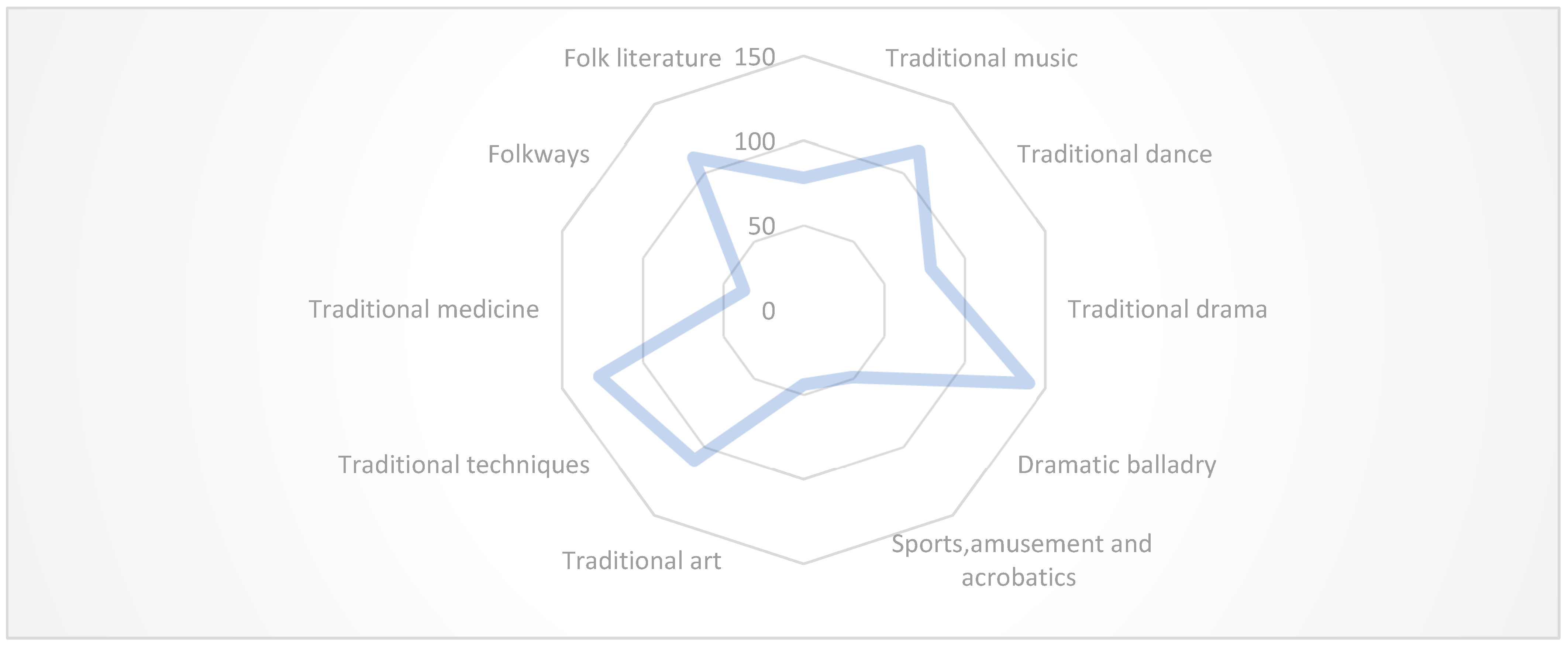
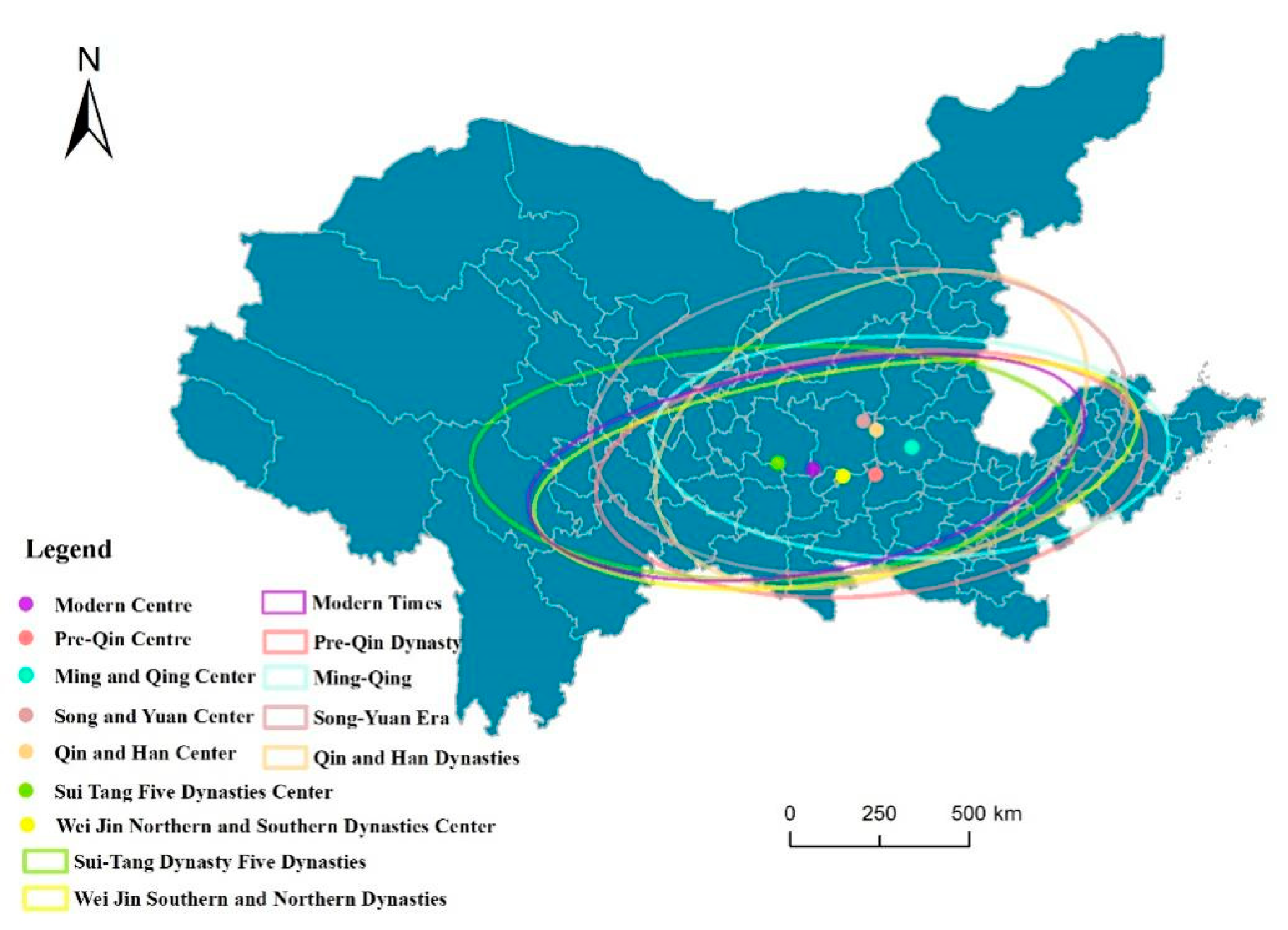
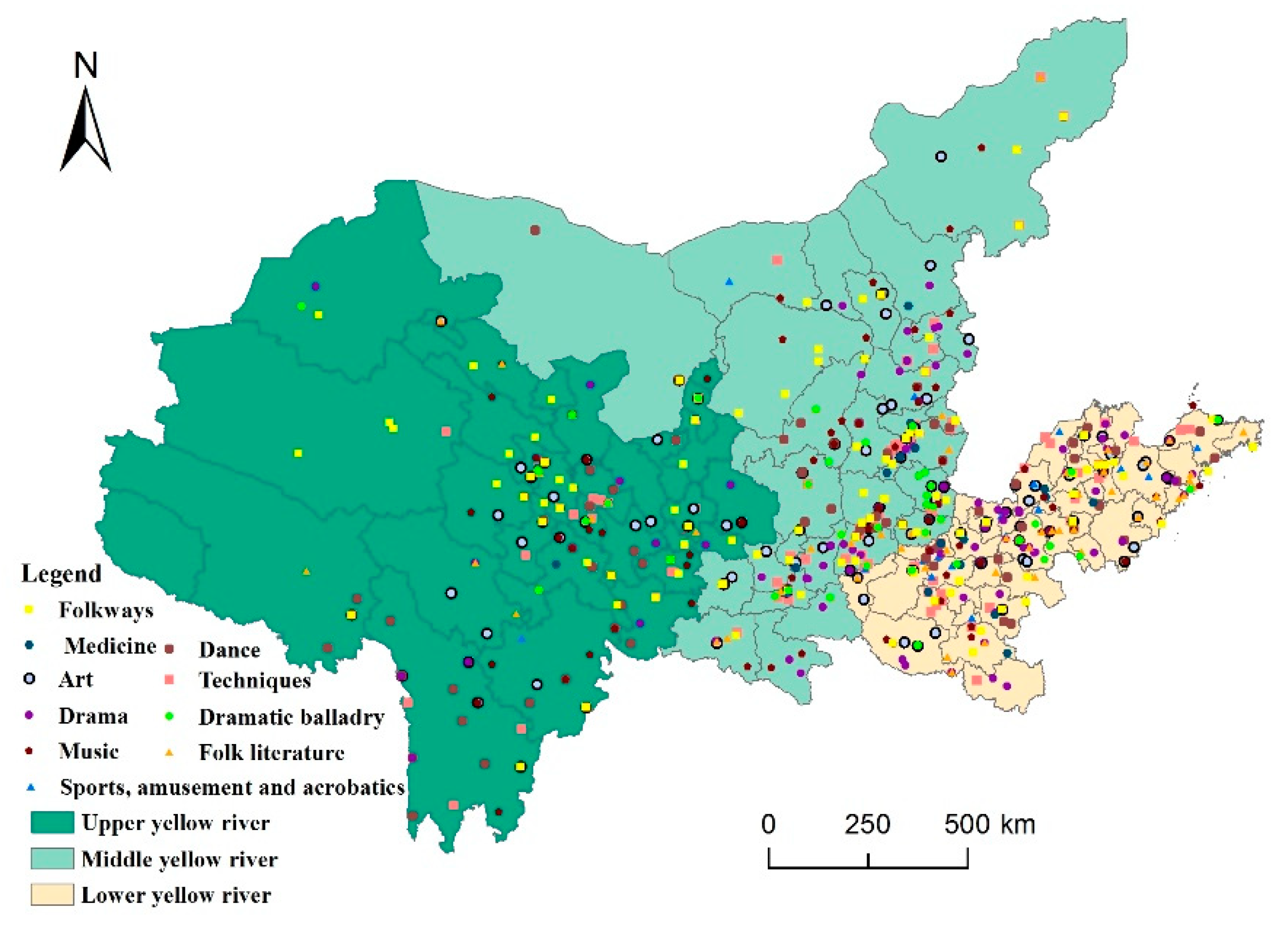
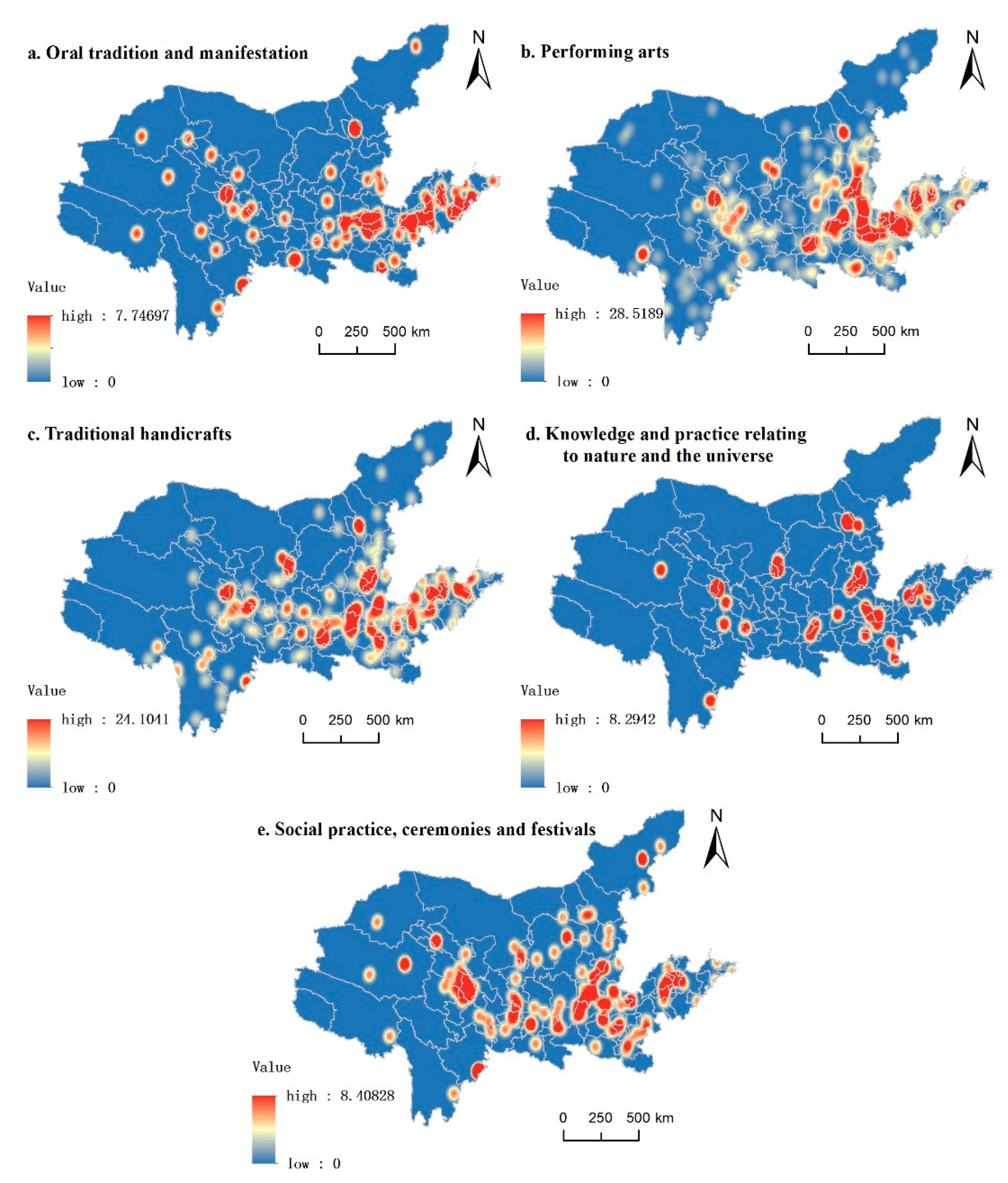
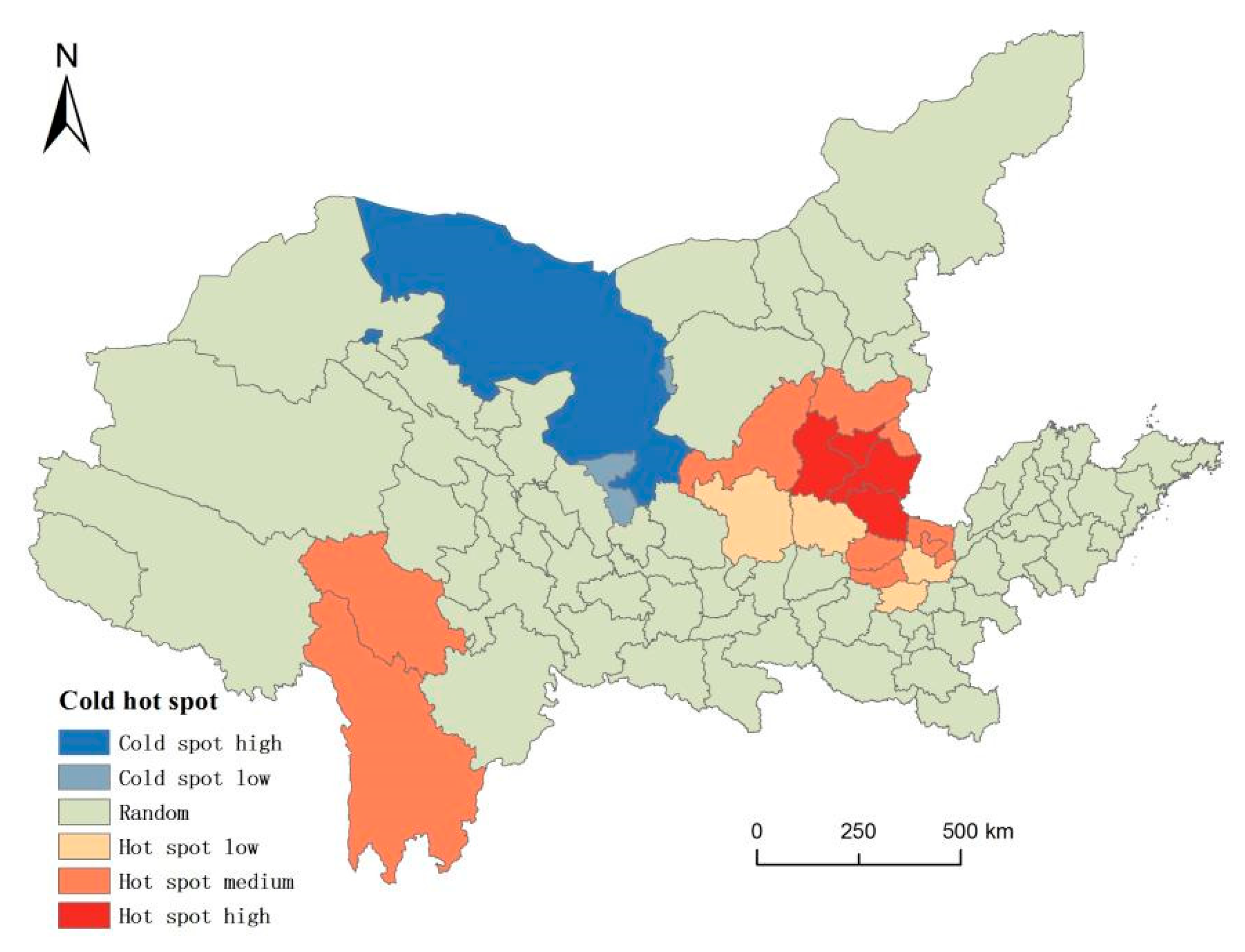
| Level | Mother Batch | Second Batch | Third Batch | Fourth Batch | Fifth Batch | Footing |
|---|---|---|---|---|---|---|
| National level of the Yellow River Basin (item) | 176 | 366 | 132 | 111 | 106 | 891 |
| National level (item) | 763 | 1352 | 567 | 463 | 465 | 3610 |
| Proportion (%) | 23.1 | 27.1 | 23.3 | 24.0 | 22.8 | 24.7 |
| Dynasty Segmentation | Folk Literature | Music | Dance | Drama | Dramatic Balladry | Sports, Amusement, and Acrobatics | Art | Techniques | Medicine | Folkways | Footing |
|---|---|---|---|---|---|---|---|---|---|---|---|
| Pre-Qin period | 36 | 13 | 20 | 6 | 1 | 6 | 17 | 27 | 6 | 27 | 159 |
| Qin and Han Dynasties | 9 | 11 | 3 | 1 | 0 | 6 | 16 | 18 | 1 | 10 | 75 |
| Wei, Jin, and Southern and Northern Dynasties | 4 | 10 | 7 | 0 | 0 | 2 | 5 | 2 | 2 | 6 | 38 |
| Sui, Tang, and Five Dynasties | 11 | 16 | 11 | 11 | 2 | 3 | 15 | 23 | 4 | 13 | 109 |
| Song and Yuan period | 9 | 19 | 7 | 10 | 5 | 8 | 16 | 18 | 4 | 21 | 117 |
| Ming-Qing period | 9 | 45 | 31 | 105 | 40 | 18 | 41 | 35 | 19 | 34 | 377 |
| Modern times | 0 | 2 | 0 | 7 | 1 | 1 | 0 | 4 | 1 | 0 | 16 |
| Footing | 78 | 116 | 79 | 140 | 49 | 44 | 110 | 127 | 37 | 111 | 891 |
| Partition | Number (Item) | Proportion (%) | Area (10,000 km2) | Density (Item/10,000 km2) |
|---|---|---|---|---|
| Upper Yellow River | 246 | 27.6 | 145.17 | 1.69 |
| Middle Yellow River | 334 | 37.5 | 108.36 | 3.08 |
| Lower Yellow River | 311 | 34.9 | 32.28 | 9.63 |
| Grand total | 891 | 100 | 285.81 | 3.12 |
| Batch/Type | Average Nearest-Neighbor Distance (km) | Expected Nearest-Neighbor Distance (km) | NNI | Z Value | p Value | Dispersion Pattern |
|---|---|---|---|---|---|---|
| Mother batch | 35 | 65 | 0.530 | −11.927 | 0.000 | Aggregation-random |
| Second batch | 24 | 48 | 0.495 | −18.487 | 0.000 | Aggregation |
| Third batch | 42 | 66 | 0.640 | −7.914 | 0.000 | Aggregation-random |
| Fourth batch | 59 | 80 | 0.741 | −5.226 | 0.000 | Aggregation-random |
| Fifth batch | 70 | 79 | 0.884 | −2.291 | 0.022 | Random distribution |
| Folk literature | 79 | 102 | 0.774 | −3.817 | 0.000 | Aggregation-random |
| Traditional music | 56 | 74 | 0.761 | −4.921 | 0.000 | Aggregation-random |
| Traditional dance | 67 | 99 | 0.681 | −5.420 | 0.000 | Aggregation-random |
| Traditional drama | 44 | 70 | 0.632 | −8.326 | 0.000 | Random distribution |
| Dramatic balladry | 74 | 89 | 0.823 | −2.369 | 0.018 | Random distribution |
| Traditional sports, amusement, and acrobatics | 95 | 117 | 0.808 | −2.435 | 0.015 | Random distribution |
| Traditional art | 57 | 77 | 0.739 | −5.246 | 0.000 | Aggregation-random |
| Traditional techniques | 41 | 74 | 0.547 | −9.758 | 0.000 | Aggregation-random |
| Traditional medicine | 72 | 104 | 0.694 | −3.560 | 0.000 | Aggregation-random |
| Folkways | 59 | 81 | 0.720 | −5.640 | 0.000 | Aggregation-random |
| Entire | 115 | 313 | 0.369 | −36.037 | 0.000 | Aggregation |
| Criterion Layer | Indicator Layer | q | p |
|---|---|---|---|
| Physical factor | Terrain | 0.1531 | 0.0000 |
| Climate | 0.1306 | 0.0000 | |
| Hydrology | 0.1199 | 0.0000 | |
| Economic factor | Total GDP | 0.2332 | 0.0000 |
| Per capita GDP | 0.3233 | 0.0000 | |
| Sociocultural factors | Cultural partition | 0.0435 | 0.0000 |
| Policy support | 0.4256 | 0.0000 |
| Impact Factors | Terrain | Climate | Hydrology | Total GDP | Per Capita GDP | Cultural Partition | Policy Support |
|---|---|---|---|---|---|---|---|
| Terrain | 0.1531 | ||||||
| Climate | 0.3416 * | 0.1306 | |||||
| Hydrology | 0.3774 * | 0.2207 + | 0.1199 | ||||
| Total GDP | 0.6310 * | 0.3494 + | 0.4129 * | 0.2332 | |||
| Per capita GDP | 0.7004 * | 0.5562 * | 0.5484 * | 0.6658 * | 0.3233 | ||
| Cultural partition | 0.5055 * | 0.1461 + | 0.1246 + | 0.3588 * | 0.4002 * | 0.0435 | |
| Policy support | 0.6208 * | 0.6513 * | 0.6945 * | 0.8299 * | 0.7893 * | 0.6393 * | 0.4256 |
Publisher’s Note: MDPI stays neutral with regard to jurisdictional claims in published maps and institutional affiliations. |
© 2022 by the authors. Licensee MDPI, Basel, Switzerland. This article is an open access article distributed under the terms and conditions of the Creative Commons Attribution (CC BY) license (https://creativecommons.org/licenses/by/4.0/).
Share and Cite
Zhang, Z.; Li, Q.; Hu, S. Intangible Cultural Heritage in the Yellow River Basin: Its Spatial–Temporal Distribution Characteristics and Differentiation Causes. Sustainability 2022, 14, 11073. https://doi.org/10.3390/su141711073
Zhang Z, Li Q, Hu S. Intangible Cultural Heritage in the Yellow River Basin: Its Spatial–Temporal Distribution Characteristics and Differentiation Causes. Sustainability. 2022; 14(17):11073. https://doi.org/10.3390/su141711073
Chicago/Turabian StyleZhang, Zhongwu, Qi Li, and Shixiong Hu. 2022. "Intangible Cultural Heritage in the Yellow River Basin: Its Spatial–Temporal Distribution Characteristics and Differentiation Causes" Sustainability 14, no. 17: 11073. https://doi.org/10.3390/su141711073
APA StyleZhang, Z., Li, Q., & Hu, S. (2022). Intangible Cultural Heritage in the Yellow River Basin: Its Spatial–Temporal Distribution Characteristics and Differentiation Causes. Sustainability, 14(17), 11073. https://doi.org/10.3390/su141711073





